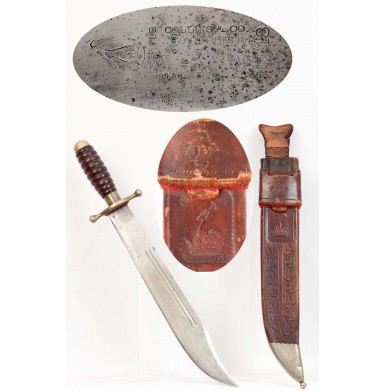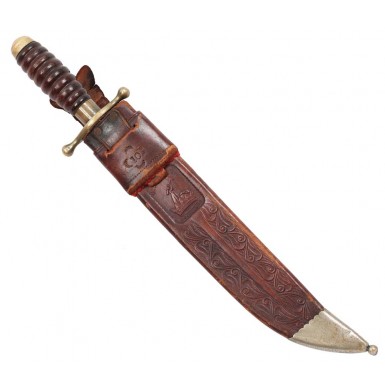The Collins No 18 “Bowie” Knife is one of the more misunderstood and misidentified edged weapons to be manufactured by that famous blade and tool making company. While the “knife” has a distinctly military appearance, and most readily appears to be a “Bowie Knife”, the No 18 (and is even listed in the 1896 Collins & Company Edge Tool Register as “BOWIE No 18”), the Collins company always considered the product a machete, and by the early 1900’s company literature reflected that designation. According to Collins: Machetes and Bowies 1845 “ 1965 by Daniel Edward Henry, the model numbers were serialized from 1 upwards upon introduction of a product line, and the No 18 machete pattern was initially introduced circa 1847. While the overall shape and appearance of the No 18 would evolve over the years, the designation would mean that the blade of the machete was either 12”, 14”, 16” or by special order 18” long. After 1926 the designation of “No 17” for the 10” variant was dropped, and 10” blades were also listed as “No 18” machetes. The distinctly late 19th century military appearance of the pattern appears to be more the result of plagiarism by the US military than an attempt by Collins to market the No 18 as a military knife or machete. The No 18 design from the mid-1870’s until the end of production is very much reminiscent of the US M-1887 Hospital Corps Knife, which was in fact a nearly direct copy of the Collins Hospital Corps Machete that had been designed during the American Civil War. Collins had hoped their design would be adopted and purchased in large numbers during the war, but it never was. However, Collins did manage to sell some of these Hospital machetes to state militias after the war, and during the 1875 Philadelphia Exhibition, displayed high grade variants of the “knife” with Spanish markings; likely in an attempt to market them in Central & South America. It was only natural when they started production of the No 18 “Machete” that they use fittings and hardware that they were already set up to manufacture and may have had large stocks of due to their failure to obtain a US military contract. Like the Hospital Corps Machete and its military copy, the No 18 of the late 19th century featured a “corrugated” or grooved leather handle (called “Fancy Leather” by Collins), with a brass crossguard and mountings. While many early reference books (and even some later ones) misidentify this handle has being wood, it is in fact leather. The blade was distinctly “Bowie” in appearance, with a hollow ground, (somewhat exaggerated) clip point blade that tapered at the ricasso. The false edge of the clip point could be had either sharpened or unsharpened. The blades had two fullers or grooves cut into the upper edge on each side to lighten the blades. The reverse ricasso was typically marked with the model number and a variety of Collins logo stamps, depending upon the intended point of sale or destination. The “machetes’ were sold with a variety of scabbards, including the No 10 for the smaller “Bowie” style knives and the No 5 for the larger “machetes”. Over the decades the No 18 evolved into a variety of other patterns, with the most universally recognizable version being the No 18 US Army Air Force Survival Knife, known erroneously to most collectors as the V-44 Survival Knife.
This Collins No 18 Machete is the classic “Bowie style” knife typical of production during the last quarter of the 19th century. The knife has a 12” clip point Bowie blade with a lightly sharpened false edge. It is mounted in brass with a penned pommel cap and ball finial crossguard. The reverse ricasso is marked with three separate stamps. The model designation No 18 is stamped parallel to the guard. The five-line makers mark is stamped perpendicular to the guard and reads: COLLINS & CO / HARTFORD / ACERO FINO / CALIDAD / GARANTIZADA. The “Spanish” label suggests the knife was meant to be sold or marketed in Central or South America, but often these knives were simply sold in the states. The Spanish portion of the legend translates to: "fine steel / quality / guaranteed". Finally, the Collins Legitumus Logo is stamped parallel with the guard, furthest from the hilt, showing the Arm & Hammer with Crown logo, over that word. That logo appears to have come into use around 1875. The machete is contained in an early style No 10 scabbard with a ball tip finial. This scabbard pattern was used from about 1875 through approximately the turn of the century. The scabbard is embossed with No 10 on the frog and with the Collins & Co in an arc over the Arm & Hammer / Crown / Legitimus logo. The knife is in NEAR FINE condition. The 12” blade is full length and shows only minimal, light sharpening. The blade has a dull pewter patina, with some scattered areas of salt & pepper surface discoloration, and some light pinprick oxidation, which is most noticeable near the ricasso. The “Fancy Leather” hilt is in FINE condition and the leather handle remains crisp and sharp with only some minor light handling wear and scuffing. The brass crossguard and pommel cap have a lovely medium golden patina. The blade, hilt and crossguard are all tight and firm with no perceptible wiggle or shake. The leather washer at the ricasso is a more modern replacement. The leather scabbard is in about VERY GOOD condition. The leather remains strong and supple, with crisp embossing on the front. All of the stitching remains tight and secure and the rear seam shows no damage at all. The frog is in place and secure, but the belt loop portion is damaged and is no longer complete. The scabbard retains nearly all of its original leather finish, with only some minor scuffing and finish loss, while the remains of the belt loop show significant finish flaking. The original German silver ball tipped scabbard finial is present and in lovely condition. The tip is somewhat loose, but remains on the scabbard. both of the original pins that secured the tip to the scabbard are missing, but the tip remains in place as long as it is not pulled on or handled roughly.
Overall this is a very attractive example of a late 19th century Collins No 18 “Bowie” Machete. These knives saw significant use during the Spanish American War, and many of these knives accompanied US troops to Cuba. These were popular multi-use hunting and sporting knives during their time, and even Abercrombie & Fitch of New York offered them for sale during the 1890’s. There is also indication that some of these knives saw use on both sides during the Boer Wars in South Africa. What is even more interesting is that this is really the grandfather of the “V-44” USAAF survival knife of the 1930’s and early 1940’s. Even though this was never an official US military knife, it deserves a place in any advanced edged weapons collection, as one of those transitional knives that melded the designs of the mid-19th century, Civil War era into the knives of the modern, WWII era. The scabbard is very nice and retains the often-missing frog, even if the belt loop is damaged. All in all this would be a nice knife to add to your collection and would be a great piece to display along with a USAAF survival knife and the edged weapons of the Spanish American War.
SOLD





